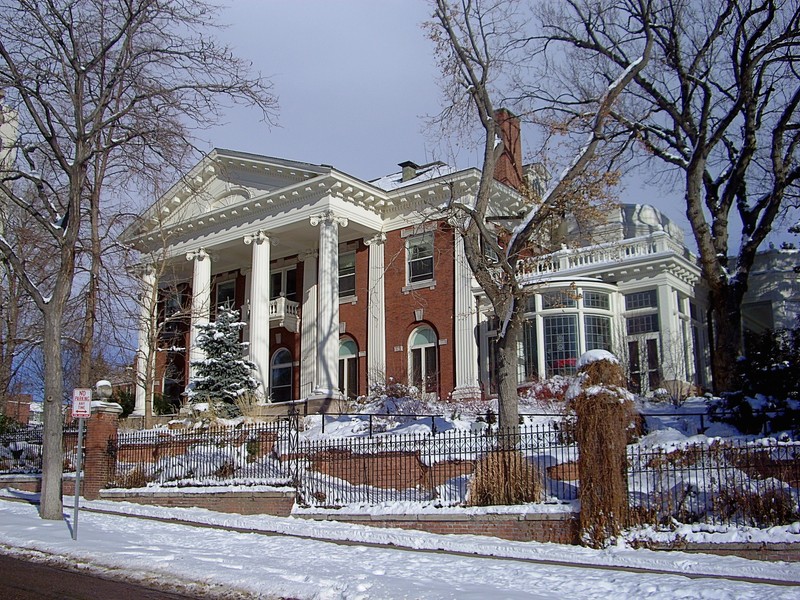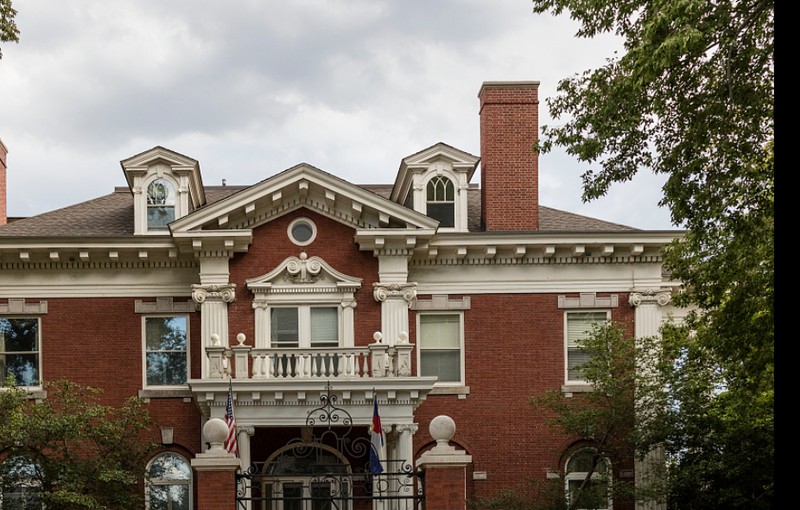Boettcher Mansion, Colorado Governor's Mansion
Introduction
Text-to-speech Audio
Images
The Colorado Governor's Mansion seen in the winter.

The Colorado Governor's Mansion. Photo by Carol M. Highsmith. Gates Frontiers Fund Colorado Collection within the Carol M. Highsmith Archive, Library of Congress, Prints and Photographs Division.

Backstory and Context
Text-to-speech Audio
When pioneering Colorado businessman Walter S. Cheesman set out to build his dream house, he selected a prime site at the southeast corner of Logan Street and Eighth Avenue, at the corner of Capitol Hill, with views west to Mount Evans and south toward’s Pike’s Peak. The Grant-Humphreys Mansion already stood on the Pennsylvania Street side of the same block. The Spanish Colonial style Malo mansion would be built between the two houses in the 1920s, while the remainder of the block was converted to a small public park, now known as Governor’s Park.
Sadly, Cheesman died before the ground had even been broken. His widow and teenaged daughter over the saw the construction of the three-story Colonial Revival style, mansion designed by the Denver architectural firm of Marean and Norton, who also designed the white marble pavilion in the park that bears Cheesman’s name.
In 1923, after the death of Cheesman’s widow, the house was purchased by Claude K. Boettcher, often described in his lifetime as “the richest man in the west”. Claude Boettcher built on a fortune bequeathed him by his father, Denver businessman Charles Boettcher, and another Boettcher Mansion, a hunting lodge built by Charles atop Lookout Mountain, is maintained by Jefferson County (a third Boettcher family property, in Hawaii, is also now public).
In the 1940s, Claude Boettcher was memorably described by journalist John Gunther : “If I were a casting director in Hollywood and wanted a type to play one of the old railroad barons of the last century, I would hireMr. Boettcher at once. This margrave of the sugar beets, this padishah of cement, potash, mining, what not, one of the richest men in America and one of the least known, is a magnate like the antique Astors and Vanderbilts.” Boettcher used his wealth to establish the philanthropic Boettcher Foundation, which supports a wide range of nonprofit activities including scholarships, medical research, and the arts.
Boettcher rebuilt the porch at the back of the house into the glass-enclosed Palm Room, floored in white Colorado Yule marble and facing south towards distant Pike’s Peak. The well-traveled Boettcher filled the house with art and antiques, including tapestries, eighteenth-century French and Venetian furniture, and 1,000-year-old Tang dynasty figurines. Among Boettcher’s more notable acquisitions was a Waterford crystal chandelier which had hung in the White House in 1876, the year Colorado achieved statehood.
On his death in 1957, Boettcher left the house and its contents to the state of Colorado for use as a governor’s residence. The state was reluctant at first to accept this gift, but took possession of the mansion in 1959. It is open to the public for tours on Tuesday afternoons in the summer, and during the holiday season, when the house is decorated for Christmas, and is frequently used for receptions and events. Private quarters for the governor and his family are on the third floor, though not all recent governors have chosen to live in the house.
